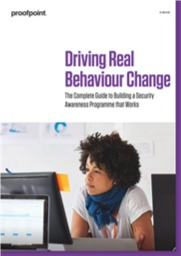Driving Real Behaviour Change
Today's most potent cyber threat isn't a zero-day vulnerability, new malware or the latest exploit kit. It's your own users. That's because today's attacks target people, not IT infrastructure. No matter what form they take, most cyber attacks need a human victim to help activate them. They trick people into opening malicious attachments, clicking unsafe URLs, handing over account credentials and even taking direct action— such as wiring money or sending sensitive data.
This guide shows you how to create and sustain an efficient and effective cybersecurity education programme—regardless of your programme maturity, vendor or obstacles you may face. It provides key facts, effective strategies, valuable resources and practical tips for security leaders at every stage of the security awareness journey.
Read More
By submitting this form you agree to Proofpoint contacting you with marketing-related emails or by telephone. You may unsubscribe at any time. Proofpoint web sites and communications are subject to their Privacy Notice.
By requesting this resource you agree to our terms of use. All data is protected by our Privacy Notice. If you have any further questions please email dataprotection@techpublishhub.com
Related Categories: AIM, Cloud, Compliance, Email, Email Security, IT Security, Malware, Mobile Security, NAS, Network, SAN, Software, Spam, Wi-Fi


More resources from Proofpoint

10 Biggest and boldest insider threats
Over the last two years alone, insider security incidents have jumped 47%, with the average cost per incident up 31%. That risk is only increasing ...

AGRAVIS Protects Critical Networks for Agricu...
The agricultural trading services business is part of a unique industry. AGRAVIS Raiffeisen AG is a leader in this arena. Based in Germany, the com...

What Every Security Professional Should Know ...
What Every Security Professional Should Know About Third-Party OAuth Apps: An FAQ and Security Checklist for CISOs
The volume of third-party ...